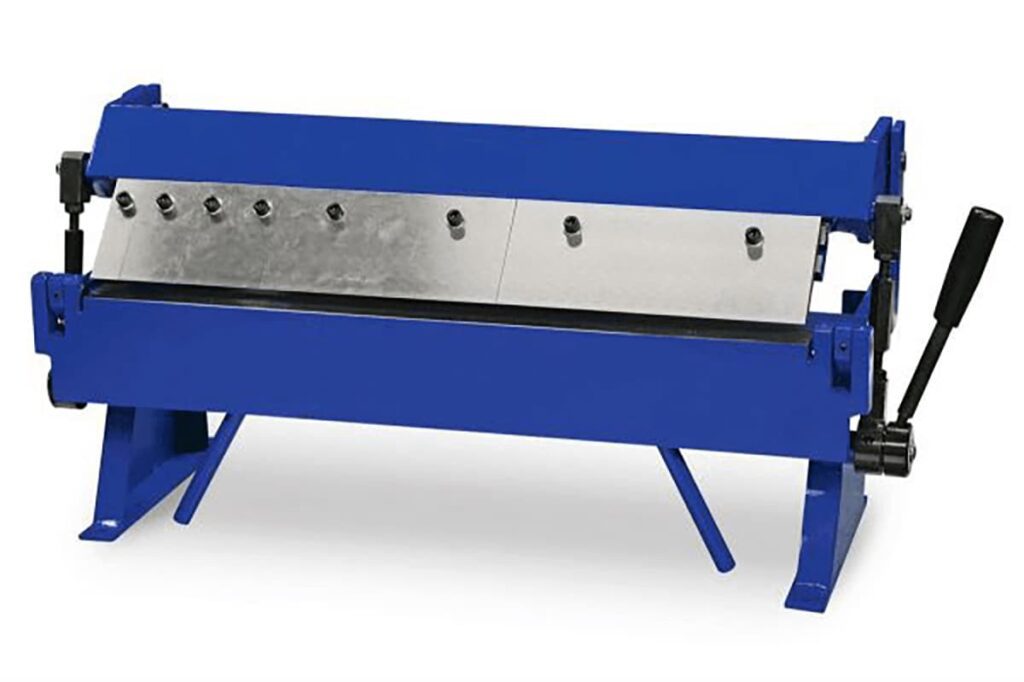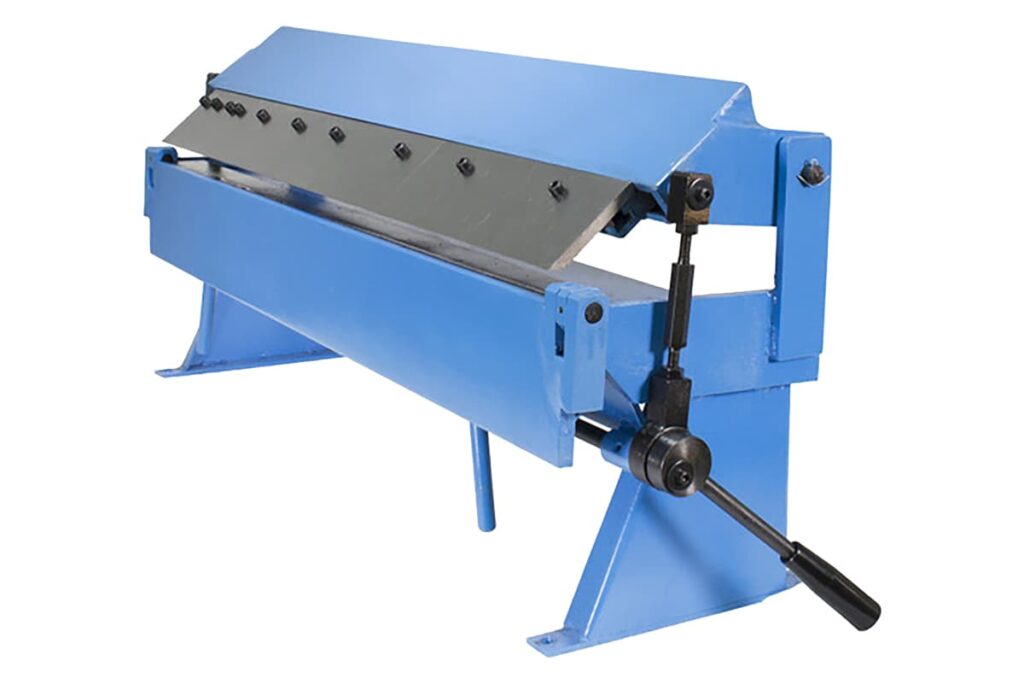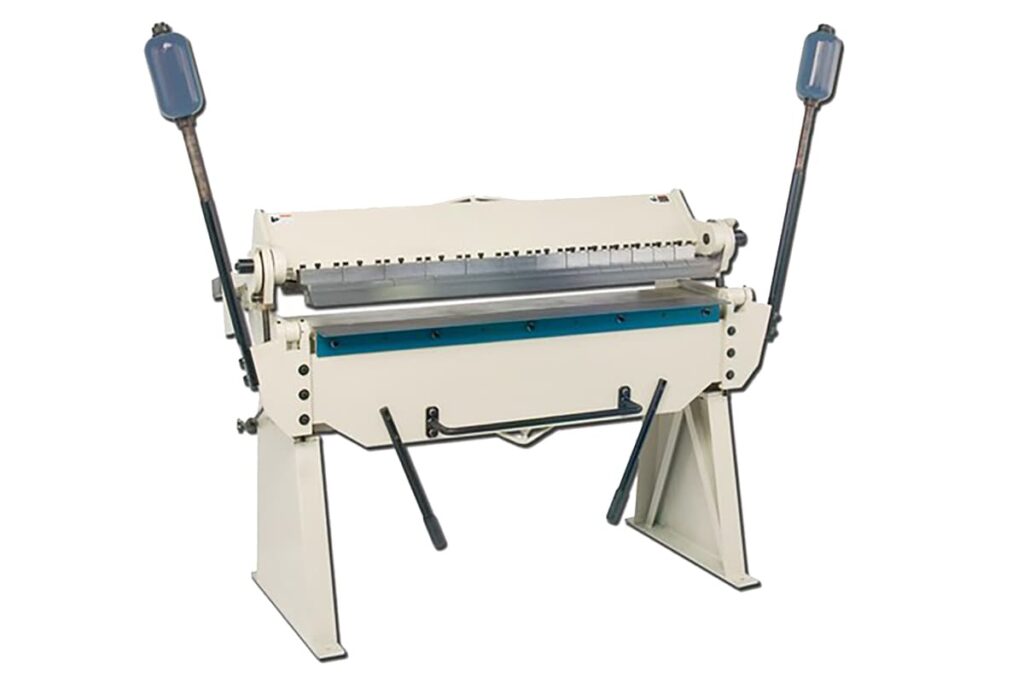A finger brake is a versatile machine which is applied in the fabrication of sheet metal. It uses adjustable fingers or clamping bars to bend and fold metal sheets into various shapes and angles accurately. It offers high precision and applies widely in industries such as automotive and construction. In a finger brake, adjustable fingers are metal strips or bars that can be positioned at different heights and distances from the clamping bar. They play a pivotal role in supporting the metal sheet during the bending process and determining the shape and angle of the bend. By adjusting the position and height of the fingers, operators can achieve precise and consistent bending results, allowing for widespread applications and flexibility in metal fabrication. (1) Versatility: finger brakes boost a wide range of applications and can handle various materials and thicknesses. (2) Precision: The adjustable fingers allow for precise control over the bending process, resulting in accurate and consistent bends, especially for complex shapes and angles. (3) User-friendly: finger brakes are designed with intuitive controls and adjustments, making them accessible to operators with different levels of experience. (4) Cost-effectiveness: finger brakes are often more affordable compared to other bending methods, making them a cost-effective choice for small and medium-sized businesses. (5) Efficiency: finger brakes contribute to increased production efficiency due to quick setup times, faster bending speeds, and ease of operation. (6) Safety: finger brakes incorporate safety features such as protective guards and interlocks to minimize the risk of accidents during bending, ensuring operator safety. Overall, finger brakes offer versatility, precision, user-friendliness, cost-effectiveness, efficiency, and safety, making them a preferred choice in many metal fabrication applications over other bending methods. Finger brakes are widely used in various industries due to their ability to perform precise and intricate bends on metal sheets. They provide accurate metal bending and forming capabilities for components such as brackets, panels, frames, structural parts, and piping systems, ensuring quality and precise assembly in various applications. Their applications range from manufacturing industries like automotive and aerospace (helping produce complex parts) to the construction industry (used for shaping metal frames and roof panels). The electronics industry also utilizes this tool for fabricating metal enclosures for various devices. Furniture manufacturers use it to create metal components, while artists use it for crafting intricate metal sculptures. Additionally, its role in rapid prototyping across different sectors and as an educational tool in vocational colleges emphasizes its versatility and importance in metal fabrication. The main advantage of a finger brake is its adaptability, particularly with a kit of different finger sizes. It can achieve various bending lengths and shapes, ranging from long straight bends to box and pan shapes. Fingers can be rearranged or even removed to achieve complex bends and folds that standard straight press brakes cannot accomplish. The finger brake mainly consists of manual finger brake, hydraulic finger brake, pneumatic finger brake, CNC finger brake, sheet metal brake, electric finger brake etc. Typically is hydraulic finger brake, a machine used in metal fabrication that utilizes hydraulic power to accurately bend and shape metal sheets. It is equipped with adjustable fingers or stops that aid in precise bending and folding operations. In a finger brake (also known as a box and pan brake), finger brake tooling is used to generate bends in specific areas of a workpiece, such as a metal sheet, without affecting the rest of the workpiece. The "fingers" are movable blocks that can be adjusted to accommodate different sizes and shapes of workpieces. When you need to perform a bend, you place the metal sheet on top of the fingers, arranging the fingers to match the desired bend. Then, the clamping bar descends, securing the workpiece in place. Next, the bending blade (essentially a flat part located underneath the workpiece) is raised, causing the metal around the fingers to bend. The key function of finger brake tooling is to achieve precise and intricate bends, which is particularly useful in creating boxes, pans, or other objects with specific shapes. A finger brake has different types of tooling, including V-dies, U-dies, hemming dies, and radius dies. Each type has a specific shape and purpose, allowing for a variety of bending possibilities. V-dies are commonly used and have a V-shaped groove that creates sharp bends in the metal. U-dies have a U-shaped groove and are suitable for making flanges or bending tubes with a slot. Hemming dies are designed for folding and overlapping metal edges, often used for seams or joining two pieces of metal together. Radius dies have a curved bending surface and are used to create bends with a specific radius. They are ideal for applications that require smooth, rounded bends. Choosing the appropriate tooling is crucial for achieving precise and desired bends. The selection depends on factors such as material type, thickness, required bending angle, and bending radius. Different tooling options have varying levels of precision, allowing for flexibility in creating different shapes and angles. Understanding the characteristics of different tooling and their compatibility with specific materials helps optimize the bending process, resulting in high-quality and consistent bends. A "finger brake kit" usually includes a variety of tools and components that are designed to be used with a press brake for the purpose of bending sheet metal. The exact contents can vary based on the specific kit and manufacturer, but commonly, these kits may include: Finger Dies: These are the main components of the kit and come in a variety of sizes to accommodate different bend lengths. They are shaped to allow for the bending of specific sections of a workpiece without affecting other areas. Mounting Hardware: This includes bolts, nuts, and other fasteners required to secure the dies and clamping bars to the press brake. Adjustment Tools: These may include wrenches or other tools used to adjust the position of the finger dies or clamping bars. Storage Case: Many kits also come with a case or box for storing and transporting the components. User Manual: Instructions on how to safely and effectively use the finger brake dies and other components in the kit. Press Brake Body: This is the main structure that supports the tooling and applies the force necessary for bending. Lower Die or Bending Die: This is the lower tooling element that the sheet metal is pressed against Support Equipment: Depending on the complexity of the kit, it might include additional equipment such as: Back Gauges: These are positioning tools that help ensure the workpiece is aligned properly for precise bends. Side Gauges: These help ensure that the workpiece is square to the bending line. Clamping Tools: These tools are used to hold the workpiece securely in place during bending. (1) Safety First: Always wear protective gear, including safety glasses, gloves, and steel-toed boots. Ensure the workspace is clean and free of debris. (2) Plan Your Bends: Determine the order of bending and mark the bending spots on the workpiece. (3) Align the Finger Dies: Arrange the finger dies on the upper beam based on the shape you want to bend. Align them according to your bending requirements. The fingers should correspond to the marked positions on the workpiece. (4) Material Placement: Place the metal sheet on the bending die, using the backgauge to ensure it is in the correct bending position. The side rule can help ensure the sheet is perpendicular to the bend line. (5) Bending: Once the workpiece is properly positioned, lower the upper beam to form the bend. Some bending machines are manually operated, requiring the operator to apply force, while others are hydraulic or electric, needing the operator to press a button or pedal. (6) Reposition for Further Bending: If multiple bends are needed, raise the upper beam, reposition the workpiece, and repeat the process. The finger dies allow for bending without interfering with existing bends. (7) Inspection: Always inspect the workpiece after the bending process to ensure the bend is correct and meets necessary specifications. (8) Shut Down the Machine: After completion, ensure the machine is correctly shut down and the workspace is clean. (9) Maintenance: Regularly maintain the machine, keeping it clean, lubricating moving parts, and checking tools for wear or damage. When using a finger brake, safety is of paramount importance. These machines are powerful tools used for bending metal sheets, and it is crucial to understand their safety features and take appropriate preventive measures to prevent accidents and injuries. In the following section, we will explore various common safety features of finger brake and discuss important preventive measures to ensure safe operations. Safety Features: 1. Emergency Stop Button: finger brakes are equipped with easily accessible emergency stop buttons that can immediately halt the machine's operation in case of an emergency or potential danger. Operators should familiarize themselves with the location of these buttons and receive training to react quickly when needed. 2. Safety Interlocks: Many finger brakes are equipped with safety interlock systems that prevent the machine from running when safety guards or doors are open. This feature ensures that operators cannot accidentally start the machine while in unsafe positions or during maintenance work. 3. Protective Shields and Guards: finger brakes typically come with protective shields and guards to safeguard operators from potential hazards such as flying debris or contact with moving parts. It is crucial not to bypass or remove these protective devices as they play a vital role in preventing injuries. Preventive Measures: 1. Proper Training: Operators should undergo comprehensive training on finger brake operation, safety procedures, and emergency protocols. They should be familiar with the machine's user manual. They should become acquainted with the machine's control devices, understand their limitations, and receive training to identify and address potential risks. 2. Personal Protective Equipment (PPE): Operators must wear appropriate PPE, including safety glasses, gloves, ear protectors (if necessary), and safety shoes. PPE helps prevent injuries from sharp edges, flying debris, and excessive noise generated during the bending process. 3. Machine Inspection: Before operation, ensure that the machine is in good working condition. Check for secure power connections and ensure that all components are in good condition. 4. Proper Parameter Settings: Set the machine's bending angle, pressure, speed, and other parameters correctly based on the desired bending angle and material thickness. 5. Preparations Before Processing: Before processing, ensure that the worktable is clean and tidy, and the material is securely fixed to prevent accidental movement or slipping during the machining process. 6. Maintain Focus During Operation: Stay focused during operation, avoiding distractions or negligence that can lead to accidents. 7. Follow Proper Operating Procedures: Follow the correct procedures for operation, keeping hands away from moving parts of the machine to prevent crushing or other injuries. 8. Cleanliness Before Shutdown: After completing the job, promptly clean the worktable and machine, properly store materials and tools, and ensure that the machine is in a safe state. Regular maintenance, inspections, and adherence to safety guidelines ensure a safe working environment. By understanding the safety features and following necessary preventive measures, operators can significantly reduce the risk of accidents when using finger brake machines. With the continuous development of the manufacturing industry and technological advancements, finger brakes are also facing several challenges: Challenge 1: High precision requirements As product designs become increasingly complex, the precision requirements for bending parts are also becoming higher. Traditional finger brakes may encounter accuracy issues when handling intricate curves and small-sized components. Solution: Adopt advanced CNC systems: Implementing advanced CNC systems can provide more precise bending control and data processing, thereby achieving higher precision requirements. Utilize high-precision tooling: Choosing high-precision tooling can ensure better bending quality and accuracy, meeting design requirements. Challenge 2: Handling diverse shapes As product diversity and personalized demands increase, finger brakes need to be able to handle a wider range of workpiece shapes, including complex curves, irregular shapes, and three-dimensional components. Solution: Introduce multi-axis control: Employing multi-axis control systems enables more complex bending operations to meet the demands of different workpiece shapes. Utilize adjustable tooling: Opting for adjustable tooling systems allows for flexible adaptation to different workpiece shapes, while providing higher processing efficiency. Challenge 3: Automation and intelligence requirements With the development of industrial automation and smart manufacturing, users have increasingly higher expectations regarding the automation and intelligence levels of finger brakes. Traditional manual operation modes may not meet these requirements. Solution: Automated backgauge system: Implementing an automated backgauge system enables automatic workpiece positioning and backgauge adjustment, thereby improving production efficiency and consistency. Intelligent control system: Utilizing intelligent control systems enables data analysis and real-time monitoring, providing more efficient production management and fault diagnosis. Challenge 4: Sustainable development and environmental protection In the current global context of environmental protection, traditional finger brakes may face issues such as high energy consumption and excessive waste generation, which do not align with sustainable development requirements. Solution: Energy-saving design: Optimizing mechanical structures to reduce energy consumption, for example, by incorporating efficient servo drive systems and intelligent energy management technologies. Waste management: Strengthening waste classification and recycling efforts to minimize environmental impact. When facing future challenges, finger brakes need to continuously adapt and innovate. By incorporating advanced CNC systems, multi-axis control, automation and intelligence technologies, as well as solutions focused on energy efficiency and environmental protection, finger brakes can better meet the demands for high precision, diversity, automation, and sustainable development. This will provide the manufacturing industry with more efficient, flexible, and sustainable sheet metal processing solutions. Important Factors: Before making a purchase, follow these steps: ADH is a professional sheet metal machinery manufacturer with 20 years of experience. The press brake is our flagship product. We can help you choose the right press brake and provide robust after-sales support. If you need information about our press brake, please contact our sales staff or browse our press brake product page. A finger brake is a specialized tool used for bending metal, with its adjustable finger allowing for precise bending of different sizes. Its advantages over other methods include flexibility and accuracy, making it useful in diverse applications like manufacturing and construction. The hydraulic version further enhances power. Essential components include the dies that determine the bend shape. The kit usually contains various accessories for versatile operations. Using a finger brake requires understanding of the mechanics and safety precautions to prevent accidents. Ultimately, a finger brake is an indispensable tool for anyone involved in metalworking. Download the Infographic With High Resolution Fully Automatic Smc Cutting Machine Fully Automatic Smc Cutting Machine,Automatic Carbon Fiber Cutting Machines,Ceramic Fiber Machines,Composite Material Cutting Machine Laizhou Parkson Machinery Technology Co., Ltd. , https://www.baishengsmc.comI. Finger Brake Overview
1. What Is a Finger Brake

2. Adjustable Finger and Its Significance
3. Advantages Over Other Bending Methods
4. Diverse Applications of Finger Brake
5. Types of Finger Brake
II. Components and Accessories
1. Role of Finger Brake Dies
2. Types of Finger Brake Dies
3. Importance of Proper Tool Selection for Specific Applications
4. Contents of Finger Brake Kit
III. How to Use a Finger Brake


IV. Finger Brake Safety Guidelines
V. Future Challenges and Solutions
VI. Key Factors and Important Considerations in Choosing the Finger Brake
VII. Conclusion
